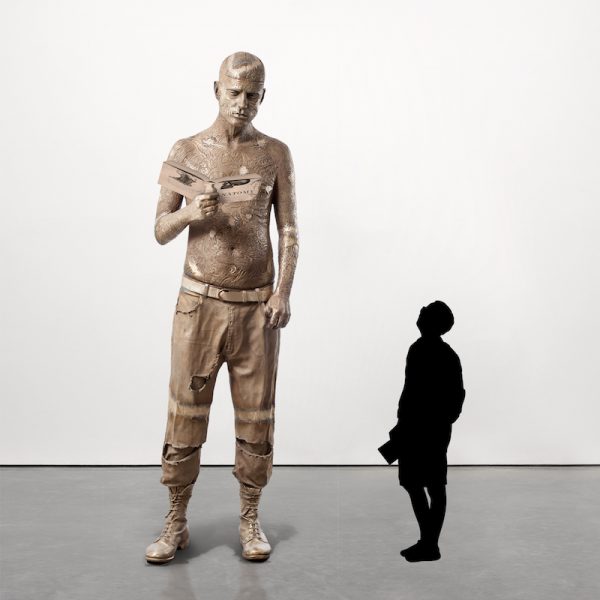London’s Science Museum has commissioned the YBA artist Marc Quinn to create a monumental sculpture for the new Medicine Galleries. Self-Conscious Gene is a sculpture of Canadian born Rick Genest, more widely known as Zombie Boy, who began covering his whole body with tattoos of his complete skeleton following a period of illness.
The 3.5 metre sculpture will welcome visitors to the GSK and Vitabiotics Vitamins funded galleries with a landmark £24 million project that will create a magnificent new home for the Museum’s world-renowned medical collection.
“After a period of illness, Rick Genest began to have the inside of his body drawn onto his skin by a tattoo artist.”
The sculpture will be unveiled in autumn 2019; Self-Conscious Gene will greet visitors as they enter the Galleries, introducing the theme of ‘Medicine and Bodies’ that this space will explore.
The work has evolved from Marc Quinn’s ongoing series entitled body alterations, which explores how, using modern medicine and technology, people have modified their outer bodies to reflect the identity they wish to project – bringing the inside out.

Through this sculpture, Quinn explores the deep yearning within humans to understand their bodies and roots. The figure will hold an encyclopaedia of anatomy, and the tension between the book and figure is designed to create a meditative atmosphere.
Artist Marc Quinn, said: “After a period of illness Rick Genest began to have the inside of his body drawn onto his skin by a tattoo artist. Literalising a quest to understand his own body, his tattoos are like a kind of poetry. His ritual mirrors our quest through medicine to understand and fix ourselves. What I love about Rick is that his body is at the crossroads of popular street culture, deep philosophical meaning, and medicine. It seemed to me that this was exactly what was needed in the Science Museum, one of my favourite museums in London, and one which I’ve been visiting since I was a child. The Museum is a mixture of knowledge, art, and wonder. I hope that this sculpture will add to all three of these elements.”
Ian Blatchford, Director of the Science Museum, said: “Artists and scientists have helped shape our sense of the body and health, and placed medicine as central to our culture. That is why we wanted to position new art commissions alongside the richly visual medical artefacts in our existing collection, to help visitors consider anew their relationship with medicine. It has been a personal ambition of mine to work with Marc Quinn for more than two decades, and I am sure our millions of visitors will be both fascinated and challenged by this remarkable sculpture for many years to come.”
Keeper of Medicine and Lead Curator of the Medicine Galleries, Natasha McEnroe, said: “Scientific discovery and exploration of the human body has transformed how medicine defines and diagnoses the disease as well as how we see ourselves, and Marc Quinn’s work perfectly expresses this central theme of the ‘Medicine and Bodies’ gallery. This sculpture will join a truly extraordinary collection of the most significant objects in medical history to help visitors discover how the medical tools, techniques and knowledge developed in the past continue to shape the practice and our experience of medicine today.”
Based on the collections of Sir Henry Wellcome and the Science Museum, the Medicine Galleries will celebrate one of the largest and most significant medical collections in the world. Over 2500 extraordinary medical artefacts, spanning more than 500 years of history, will enable visitors to discover how all our lives have been transformed by changes in medical research and practice. Set to open in autumn 2019, as a permanent display, the Medicine Galleries have been designed by architecture practice Wilkinson Eyre and will cover more than 3000m2, an area big enough to park 185 ambulances.
Marc Quinn is one of the leading artists of his generation. His sculptures, paintings and drawings explore the relationships between art and science; Man and nature; and the human body and the perception of beauty. Quinn came to prominence in 1991 with his sculpture Self (1991): a cast of the artist’s head made from eight pints of his frozen blood. Other critically acclaimed works include Alison Lapper Pregnant (2005), exhibited on the fourth plinth at London’s Trafalgar Square; Siren (2008) a solid gold sculpture of the model Kate Moss displayed at The British Museum, London; Breath (2012), a colossal replica of Alison Lapper Pregnant commissioned for the 2012 Paralympics opening ceremony and Planet (2008), a monumental rendition of the artist’s son as a baby, permanently installed at The Gardens by The Bay Singapore.
Tattooed as a living skeleton, Zombie Boy also worked in various sideshows and freak shows across Canada as an illustrated man. Not long after beginning his facial tattoos, Genest was first introduced to the public on November 13, 2006, followed in March 2008 by his first interview, by which time his iconic tattoos were largely completed. In this interview, Zombie Boy clarified that he preferred the moniker “Zombie” to “Skullboy”, as BME had been referring to him. The introductions on RzyM’s Channel led to increasingly mainstream media coverage, discovered by Marc Quinn, in Bromont, Quebec, where Zombie Boy was working with the sideshow, Alive on the Inside, at Carnivàle Lune Bleue during the Summer of 2010. On March 5, 2010, a Facebook fan page was created about Zombie Boy’s unusual choice of tattoos. This page reached 1,526,292 members (as of November 19, 2011) and ultimately led to his “discovery” by Lady Gaga’s fashion director Nicola Formichetti.
Visit Science Museum Here

